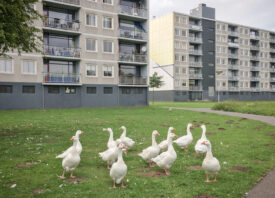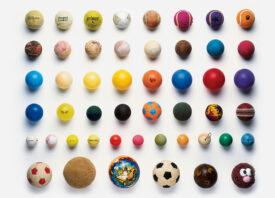Search this site
At Animal Sanctuaries, Vegan Activists Imagine a Better World



“When I called Salomé’s name, she would come directly to my hand, the one without the camera, asking to be pet,” the photojournalist Ana Palacios remembers. Salomé the kid goat arrived at Gaia Sanctuary in Spain in 2020 after she was found on the road, dehydrated, scared, and lost. She had an injured tibia, but under the care of the team at the sanctuary, she healed. With time, her fear faded, and she learned to trust.
In recent years, Palacios has traveled to four vegan sanctuaries—Gaia Sanctuary, El Hogar Animal Sanctuary, Scooby, and Eden Sanctuary—as part of her ongoing project Wild Love. In these safe havens nestled in the Spanish countryside, rescued farm animals like Salomé live out their lives in peace and freedom. Many of them have escaped abuse, exploitation, and slaughter.
“Initially, it was just an assignment,” the photojournalist tells me. “I didn’t know anything about animal abuse and the intensive livestock industry. But when I first experienced living in a sanctuary, my whole perception of the animal world changed dramatically.”
While at Gaia Sanctuary, she met Patricia, who was born in an intensive pig farm. Her mother had been confined to a gestation crate, a small iron cage that severely restricts movement (turning around is not possible). As a result of the gestation crate and her mother’s inability to move, Patricia’s legs had been crushed.
The sanctuary created a new space specifically for the young pig, where she could safely move around without injuring herself. On summer days, she can be found bathing in the pool. “A sanctuary is like a beautiful family where everybody works really hard, from dawn ’till dusk,” the photojournalist tells me.
On the night of her first visit to El Hogar Animal Sanctuary, Palacios was greeted by Elena Tova, the sanctuary’s founder and director. Upon entering the room where she would spend the next fifteen days, she spotted six cats on the bed. One of them slept cuddled up right next to her face.
Right from the start, the photojournalist witnessed firsthand just how hard the sanctuary staff and volunteers work while caring for the animals. “After long hours of work, walking long distances inside the sanctuary, and climbing up and down hills, I would go to bed at night totally exhausted,” she reflects. “I could well have shared the bed with a tiger, and that would have been fine with me!”
While at El Hogar Animal Sanctuary, Palacios also met River, a pig without teeth (likely the result of malnourishment or abuse), and Cristina Morales, a sanctuary worker with whom he’d developed a close bond. “They could be together for hours,” the photographer says. “She would prepare fresh juices for him every day and give the juices to him slowly to prevent choking. She did it with the deepest love and total devotion.”
This kind of love, which Palacios describes as “wild, unconditional, fearless, and energizing” inspired the title of her project. “Most of the time, it is a really demanding job to take care of animals,” she explains. “They don’t have free time, and they can be woken up in the middle of the night often for different reasons: an animal getting sick, a birth, or an attack from outside predators. But that love is so powerful. It gives them all the strength they need to move ahead.”
At Gaia Sanctuary, Palacios witnessed the rescue of five-day-old Armonía. “The sanctuary got the call from a nearby equestrian sports club, explaining there was this little lamb who just got her leg crushed,” she recalls. “They were going to sacrifice her if the sanctuary crew did not pick her up.
“So I went with them in the van to rescue her. We also took her mother, Tecla, so they would remain together. We went to the vet for X-rays, and then back to the sanctuary where she got her leg immobilized by Coque Fernandez de Abella, the co-founder of Gaia and a vet. I would visit her every day, and I became very fond of her. She is happily living at the sanctuary today.”
The road to rescue can look different depending on the animal. Sometimes, farmers will reach out directly to a sanctuary when the animal is no longer “of use” to them. Other times, the police might contact a sanctuary if a farmer has died or there’s been an accident. Animals might also be found on the side of the road, having fallen from transport trucks. While at the sanctuaries, Palacios learned to see every animal as an individual.
“Most of the animals were super comfortable with me being there,” she says. “They are surrounded by humans who take good care of them there all the time, so I was just one of them. I was way more scared of them than they were of me. Some of them, especially pigs, donkeys, and some goats, would come to me to be petted, but I was not ready for that at the beginning. Then as the days passed, I was really happy when they would come to me. I had long conversations with some of them, I must say.”
Whenever she’d leave to say goodbye to Salomé for the day, she was touched to hear the baby goat bleating after her. “She tried to get my attention and get me to come back,” the photojournalist tells me. “I felt the same bond that I have with my dog. I haven’t eaten meat since then.”








Some of Ana Palacios’s work on behalf of animals is represented by We Animals Media, a leading group of animal photojournalists and filmmakers documenting exploitation around the world. Support their work here.



